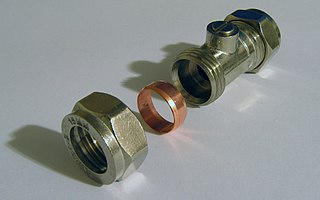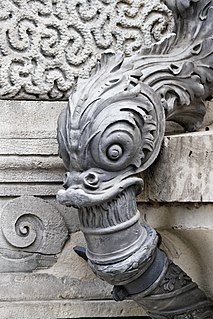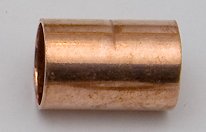
A threaded pipe is a pipe with screw-threaded ends for assembly.

A threaded pipe is a pipe with screw-threaded ends for assembly.
The threaded pipes used in some plumbing installations for the delivery of gases or liquids under pressure have a tapered thread that is slightly conical (in contrast to the parallel sided cylindrical section commonly found on bolts and leadscrews). The seal provided by a threaded pipe joint depends upon multiple factors: the labyrinth seal created by the threads; a positive seal between the threads created by thread deformation when they are tightened to the proper torque; and sometimes on the presence of a sealing coating, such as thread seal tape or a liquid or paste pipe sealant such as pipe dope. Tapered thread joints typically do not include a gasket.
Especially precise threads are known as "dry fit" or "dry seal" and require no sealant for a gas-tight seal. Such threads are needed where the sealant would contaminate or react with the media inside the piping, e.g., oxygen service.
Tapered threaded fittings are sometimes used on plastic piping. Due to the wedging effect of the tapered thread, extreme care must be used to avoid overtightening the joint. The overstressed female fitting may split days, weeks, or even years after initial installation. Therefore many municipal plumbing codes restrict the use of threaded plastic pipe fittings.
Both British standard and National pipe thread standards specify a thread taper of 1:16; the change in diameter is one sixteenth the distance travelled along the thread. The nominal diameter is achieved some small distance (the "gauge length") from the end of the pipe.
Pipes may also be threaded with cylindrical threaded sections, in which case the threads do not themselves provide any sealing function other than some labyrinth seal effect, which may not be enough to satisfy either functional or code requirements. Instead, an O-ring seated between the shoulder of the male pipe section and an interior surface on the female, provides the seal.

Plumbing is any system that conveys fluids for a wide range of applications. Plumbing uses pipes, valves, plumbing fixtures, tanks, and other apparatuses to convey fluids. Heating and cooling (HVAC), waste removal, and potable water delivery are among the most common uses for plumbing, but it is not limited to these applications. The word derives from the Latin for lead, plumbum, as the first effective pipes used in the Roman era were lead pipes.
A flange is a protruded ridge, lip or rim, either external or internal, that serves to increase strength ; for easy attachment/transfer of contact force with another object ; or for stabilizing and guiding the movements of a machine or its parts. Flanges are often attached using bolts in the pattern of a bolt circle. The term "flange" is also used for a kind of tool used to form flanges.

A tap is a valve controlling the release of a liquid or gas.

Within industry, piping is a system of pipes used to convey fluids from one location to another. The engineering discipline of piping design studies the efficient transport of fluid.

American National Standard Pipe Thread standards, often called national pipe thread standards for short, are United States national technical standards for screw threads used on threaded pipes and pipe fittings. They include both tapered and straight thread series for various purposes, including rigidity, pressure-tight sealing, or both. The types are named with a full name and an abbreviation, such as NPT, NPS, NPTF, or NPSC.

A mechanical seal is a device that helps join systems or mechanisms together by preventing leakage, containing pressure, or excluding contamination. The effectiveness of a seal is dependent on adhesion in the case of sealants and compression in the case of gaskets. The seals are installed in pumps in a wide range of industries including chemicals, water supply, paper production, food processing and many other applications.

A hose clamp is a device used to attach and seal a hose onto a fitting such as a barb or nipple.

A compression fitting is a fitting used in plumbing and electrical conduit systems to join two tubes or thin-walled pipes together. In instances where two pipes made of dissimilar materials are to be joined, the fittings will be made of one or more compatible materials appropriate for the connection. Compression fittings for attaching tubing (piping) commonly have ferrules in them, and are sometimes referred to as flareless fittings. There are also flare fittings that do not require ferrules/olives.

A screw thread, often shortened to thread, is a helical structure used to convert between rotational and linear movement or force. A screw thread is a ridge wrapped around a cylinder or cone in the form of a helix, with the former being called a straight thread and the latter called a tapered thread. A screw thread is the essential feature of the screw as a simple machine and also as a threaded fastener.

A garden hose, hosepipe, or simply hose is a flexible tube used to convey water. There are a number of common attachments available for the end of the hose, such as sprayers and sprinklers. Hoses are usually attached to a hose spigot or tap.

In plumbing and piping, a nipple is a fitting, consisting of a short piece of pipe, usually provided with a male pipe thread at each end, for connecting two other fittings.

A pipe is a tubular section or hollow cylinder, usually but not necessarily of circular cross-section, used mainly to convey substances which can flow — liquids and gases (fluids), slurries, powders and masses of small solids. It can also be used for structural applications; hollow pipe is far stiffer per unit weight than solid members.
British Standard Pipe (BSP) is a set of technical standards for screw threads that has been adopted internationally for interconnecting and sealing pipes and fittings by mating an external (male) thread with an internal (female) thread. It has been adopted as standard in plumbing and pipe fitting, except in North America, where NPT and related threads are used.

Thread seal tape is a polytetrafluoroethylene (PTFE) film tape commonly used in plumbing for sealing pipe threads. The tape is sold cut to specific widths and wound on a spool, making it easy to wind around pipe threads. Thread seal tape lubricates allowing for a deeper seating of the threads, and it helps prevent the threads from seizing when being unscrewed. The tape also works as a deformable filler and thread lubricant, helping to seal the joint without hardening or making it more difficult to tighten, and instead making it easier to tighten. It also protects the threads of both pieces from direct contact with each other and physical wear, and helps seal and prevent leaks from the connection.

In piping and plumbing, a coupling is a very short length of pipe or tube, with a socket at one or both ends that allows two pipes or tubes to be joined, welded (steel), brazed or soldered together.

A fitting or adapter is used in pipe systems to connect straight sections of pipe or tube, adapt to different sizes or shapes, and for other purposes such as regulating fluid flow. These fittings are used in plumbing to manipulate the conveyance of water, gas, or liquid waste in domestic or commercial environments, within a system of pipes or tubes.

Ground glass joints are used in laboratories to quickly and easily fit leak-tight apparatus together from interchangeable commonly available parts. For example, a round bottom flask, Liebig condenser, and oil bubbler with ground glass joints may be rapidly fitted together to reflux a reaction mixture. This is a large improvement compared with older methods of custom-made glassware, which was time-consuming and expensive, or the use of less chemical resistant and heat resistant corks or rubber bungs and glass tubes as joints, which took time to prepare as well.
Pipe dope is any thread lubricant, thread sealing compound, or anaerobic chemical sealant that is used to make a pipe thread joint leak proof and pressure tight. It is also referred to as "thread compound" or "pipe thread sealant." Although common pipe threads are tapered and therefore will achieve an interference fit during proper assembly, machining and finishing variances usually result in a fit that does not result in 100 percent contact between the mating components. The application of pipe dope prior to assembly will fill the minute voids between the threads, thus making the joint pressure tight. Pipe dope also acts as a lubricant and helps prevent seizing of the mating parts, which can later cause difficulty during disassembly.

Copper tubing is most often used for heating systems and as a refrigerant line in HVAC systems. Copper tubing is slowly being replaced by PEX tubing in hot and cold water applications. There are two basic types of copper tubing, soft copper and rigid copper. Copper tubing is joined using flare connection, compression connection, pressed connection, or solder. Copper offers a high level of corrosion resistance but is becoming very costly.

A scuba cylinder valve or pillar valve is a high pressure manually operated screw-down shut off valve fitted to the neck of a scuba cylinder to control breathing gas flow to and from the pressure vessel and to provide a connection with the scuba regulator or filling whip. Cylinder valves are usually machined from brass and finished with a protective and decorative layer of chrome plating. A metal or plastic dip tube or valve snorkel screwed into the bottom of the valve extends into the cylinder to reduce the risk of liquid or particulate contaminants in the cylinder getting into the gas passages when the cylinder is inverted, and blocking or jamming the regulator.